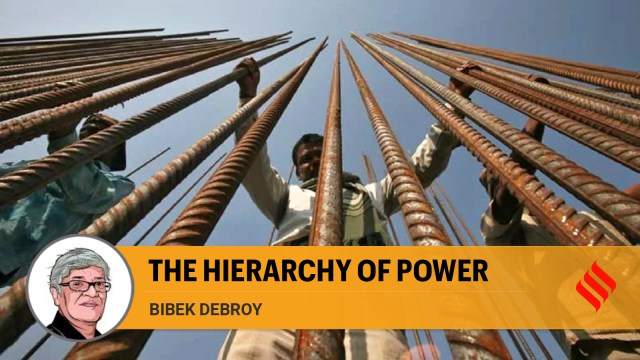
In 2022, Ashley J Tellis, C Raja Mohan and I edited a collection of essays titled Grasping Greatness, Making India a Leading Power. The book was meant to be done in 2019, but Covid delayed matters. This collection complemented an earlier one — Getting India Back on Track (2014). The title was taken from an older essay by Ashley. Notice the use of the expression “leading power”, as opposed to something like “great power”. Further down the continuum, we might have something like “super power”. Such expressions are not always precisely defined and a country’s appellation isn’t cast in stone. A leading power moves on to become a great power and graduates to super-power status. But the reverse, of a decline and fall over time, also happens. How does one define these expressions? They can be defined in terms of formal leadership in institutions that deliver global public goods (IBRD, IMF, WTO, Security Council), which adjust to altered realities and can’t be cast in stone either.
Since power flows out of the barrel of the economic gun, they can also be defined in terms of aggregate GDP (for such purposes, official exchange rates make more sense than purchasing-power parity), present and extrapolated for the future. For instance, no one can wish away India’s robust GDP growth rate and future potential. Fifth-largest economy now, the third-largest status isn’t that far off. The gold and the silver are some distance away.
GDP may be a recent metric. Before Simon Kuznets, we didn’t have a standardised template for measuring it. However, the notion of gradation of States, according to the power calculus, existed for thousands of years. Take the word rajya, meaning kingdom (I am not using the word in the sense of province or state). But we also have a word samrajya, meaning empire and clearly, samrajya is greater than rajya. We have an expression maharajya too. Is that greater or smaller than a samrajya? The respective titles of the individual heading these geographical entities are rajan, samraj and maharajan. In addition, there is the notion of a chakravartin or universal emperor, one whose chariot wheels (chakra) travelled unimpeded everywhere, right up to the shores of the ocean.
Most people have heard of rajasuya, vajapeya and ashvamedha sacrifices, though a vajapeya sacrifice may not be that familiar. A rajasuya sacrifice is a royal sacrifice, performed by a universal monarch when he is consecrated and instated as emperor, having conquered all other kings and made them tributaries (vassals?). Among others, Harishchandra and Yudhishthira performed rajasuya sacrifices. Ashvamedha is a horse sacrifice, where a horse is let loose and eventually sacrificed. Yudhishthira performed ashvamedha and this sacrifice is also a voyage of conquest.
Which is the greater sacrifice — rajasuya or ashvamedha, not to forget vajapeya? Which sacrifice makes the king, and therefore the kingdom, a greater one. The answer depends a bit on the text and I think the only text where the answer is unambiguously given is Shatapatha Brahmana. I will skip the details about the rites for each sacrifice. However, according to this text, rajasuya is the lowest of the three and having performed it, a king becomes a universal emperor or sovereign. The vajapeya sacrifice is higher. I used the word emperor or sovereign, but rajasuya still makes the individual a king. Vajapeya makes the individual a samraj. To cite chapter and verse, this is clearly stated in Shatapatha Brahmana 9.3.4.8. First, one becomes a king. Thereafter, one becomes an emperor. Therefore, vajapeya must be performed after rajasuya, never the other way around. This takes one to ashvamedha, the highest of the three. A king not satisfied with rajya or samrajya moves on to ashvamedha. One could perform multiple ashvamedha sacrifices, as Brahma did in Varanasi’s Dashashwamedh ghat.
But this doesn’t quite grade countries or economies. If the ruler is graded, the country is indirectly graded. However, we have nothing tangible and measurable. A direct gradation of countries and rulers, tangible and measurable, exists in Shukra Niti, attributed to Shukracharya. It is there right in the first chapter, on the duties of princes. The relevant verses are 365 to 374. The measurement wasn’t through GDP, but the annual revenue of the kingdom. A karsha is a gold coin. Those weren’t the days of fiat currency, but de facto, of gold and silver standards. The gold in a karsha coin weighed roughly 10 gram (Jewellers still use another such weight, known as ratti. Ninety-six rattis were one karsha). A samanta’s (often a feudatory vassal) domain had an annual revenue of one lakh to three lakh karshas. A mandalika’s territory (ruler of a small country or province, known as mandala) had three lakhs to 1 million karshas. A rajan’s kingdom had 1 million to 2 million. A maharajan’s kingdom had 2 million to 5 million. A swarat’s empire had 5 million to 10 million. A samrat had 10 million to 100 million. A virat had 100 million to 500 million.
Finally, a sarvabhouma (universal emperor) had annual revenue of more than 500 million karshas. Some of these titles may seem unfamiliar today. But we did have a taxonomy and gradation based on the kingdom’s annual revenue. Some might argue that the kingdom’s revenue is a better indicator of power than something like the GDP. In any event, the GDP didn’t exist then. Plus, there was the supplementary ranking through types of sacrifice. We did think about leading powers.
The writer is chairman, Economic Advisory Council to the PM. Views are personal
© The Indian Express Pvt Ltd
First uploaded on: 09-05-2024 at 08:02 IST


